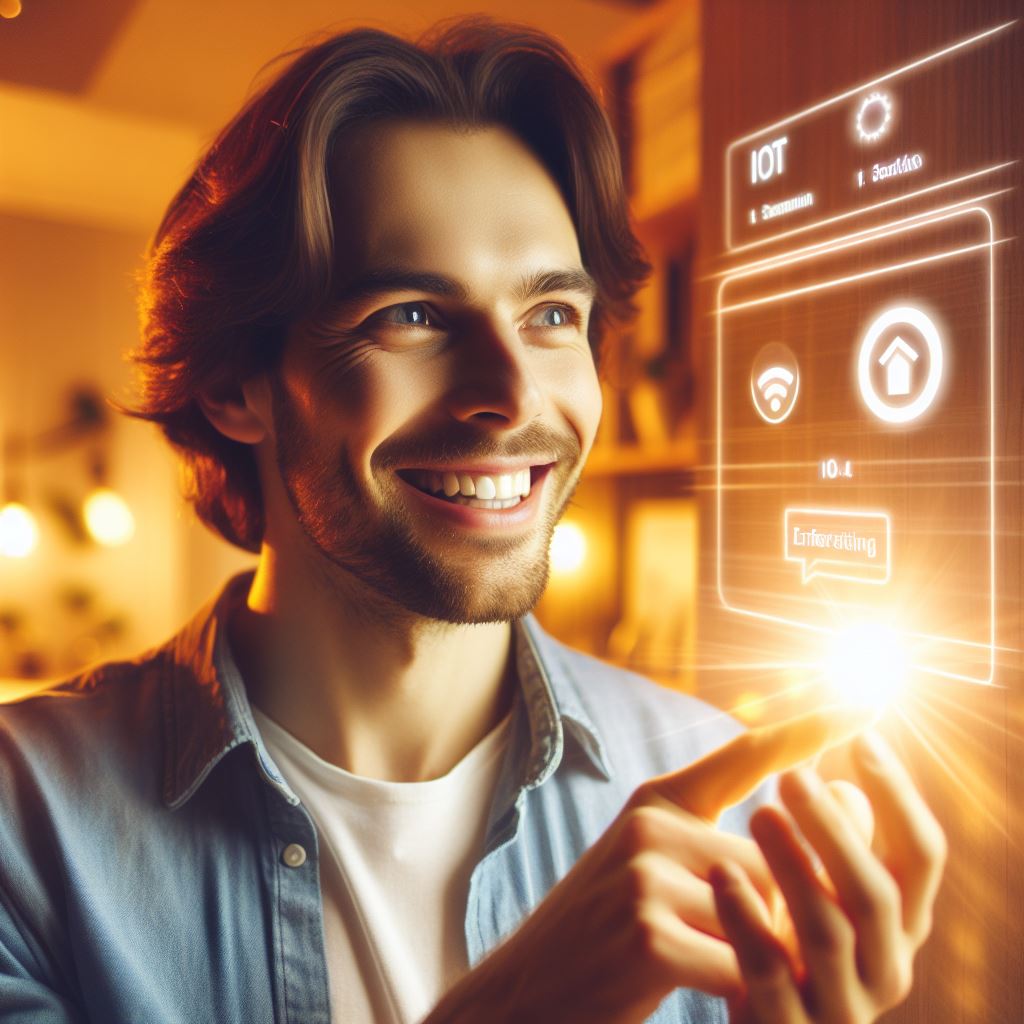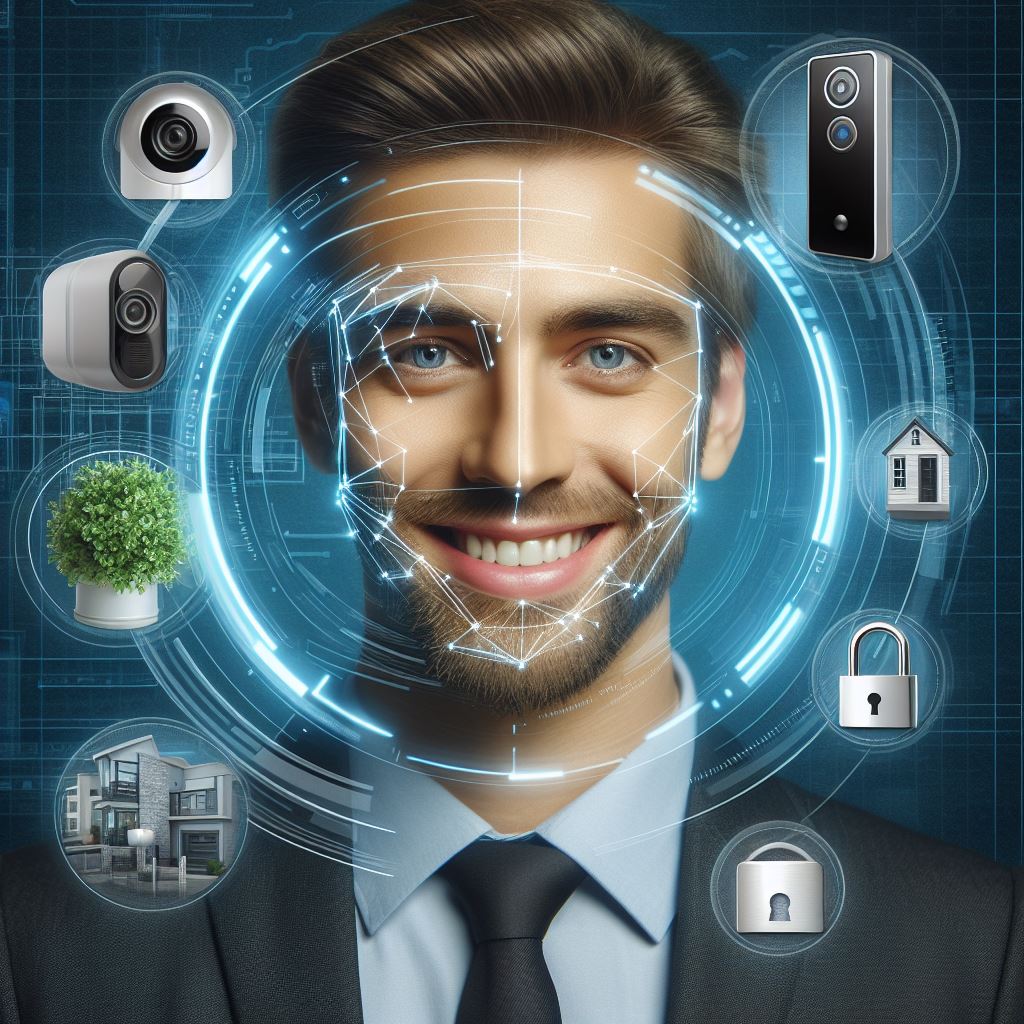Introduction
A. Embracing the Future: IoT Devices in Modern Homes
IoT devices, once futuristic dreams, are now seamlessly integrating into our homes.
Smart appliances, thermostats, and security systems redefine convenience, offering a taste of the future today.
B. A Home Revolution Unleashed
- Connectivity Galore: Witness an era where devices communicate effortlessly, bringing harmony to your living space.
- Efficiency Redefined: From automated lighting to energy-saving smart thermostats, witness efficiency at its peak.
- Security Reinvented: Sleep soundly knowing IoT-powered cameras and sensors guard your home, providing unparalleled safety.
- Personalization Triumphs: Your preferences dictate the ambiance. Customizable settings turn your house into a personalized haven.
- Time Savior: Bid farewell to mundane tasks; IoT devices automate chores, freeing up time for what truly matters – family and leisure.
In this blog series, we’ll explore how these gadgets revolutionize daily life, shaping homes into smart, efficient, and secure sanctuaries.
Get ready for the home life transformation!
Overview of IoT Devices
A. Popular examples of IoT devices
IoT devices, or Internet of Things devices, are everyday objects that are connected to the internet and have the ability to communicate with each other.
These devices are revolutionizing the way we live in our homes, providing convenience, efficiency, and enhanced security.
Let’s take a closer look at some popular examples of IoT devices:
- Smart Thermostats: These devices allow homeowners to control and monitor their home’s temperature remotely, providing energy savings and comfort.
- Smart Speakers: These devices, such as Amazon Echo or Google Home, can play music, answer questions, and control other smart devices in your home through voice commands.
- Smart Locks: With smart locks, you can unlock or lock your doors remotely, grant access to guests, and receive notifications when someone enters your home.
- Smart Lighting: These devices enable you to control and automate your home’s lighting, creating ambiance and energy efficiency.
- Smart Appliances: IoT devices have made it possible to connect appliances like refrigerators, washing machines, and ovens to the internet for remote monitoring and control.
These are just a few examples of the wide range of IoT devices available in the market today. But how do these devices work and communicate with each other?
B. How IoT devices are connected to the internet and can communicate with each other
IoT devices utilize sensors, software, and connectivity technologies to allow communication between devices.
They can connect to the internet using Wi-Fi, Bluetooth, or cellular networks. Once connected, these devices can exchange information and perform tasks based on user commands or predefined settings.
One way IoT devices communicate with each other is through cloud platforms.
Data collected from various devices is sent to the cloud, where it can be analyzed and utilized to trigger actions or provide valuable insights.
For example, a smart thermostat can receive data from sensors around the house, such as temperature and occupancy, to adjust the heating or cooling accordingly.
IoT devices can also communicate directly with each other using protocols like Zigbee or Z-Wave.
For instance, a motion sensor can send a signal to a smart light bulb, instructing it to turn on when someone enters a room.
The ability of IoT devices to communicate and work together is the key to transforming home life.
Imagine a scenario where you arrive home, and as you approach the door, your smart lock recognizes your presence and unlocks the door.
The smart lights turn on, the thermostat adjusts to your preferred temperature, and your favorite playlist starts playing on the smart speaker.
This seamless integration between devices adds convenience, personalization, and efficiency to your everyday life.
As IoT devices continue to evolve, the possibilities are endless.
From smart security systems that can detect and alert you of potential intrusions, to smart appliances that can automatically reorder groceries when you run out, these devices are reshaping the way we interact with our homes.
In fact, IoT devices are revolutionizing home life by connecting everyday objects to the internet and enabling communication between them.
The examples mentioned above provide a glimpse of the vast potential of these devices.
As technology continues to advance, we can expect even more innovative IoT devices that will make our homes smarter, more efficient, and ultimately improve our overall quality of life.
Read: Investing in Commercial Properties
IoT Devices Enhancing Home Security
Smart homes are becoming increasingly popular, thanks to the Internet of Things (IoT) devices.
These devices, like smart cameras and motion sensors, play a crucial role in enhancing home security.
A. Improved Surveillance with Smart Cameras
One of the most significant advantages of IoT devices, such as smart cameras, is their ability to enhance home security through improved surveillance.
Smart cameras can be installed both indoors and outdoors to monitor the surroundings continuously.
The footage recorded by these cameras can be accessed remotely through a smartphone or computer, providing homeowners with real-time surveillance capabilities.
Moreover, smart cameras equipped with motion detection can instantly send alerts to homeowners whenever any suspicious activity is detected.
B. Motion Sensors for Intrusion Detection
In addition to smart cameras, motion sensors are also crucial IoT devices that improve home security by detecting any unauthorized entry.
These sensors can be placed strategically throughout the house and are capable of detecting even the slightest movement.
Upon detecting any motion, the sensors send immediate alerts to homeowners, keeping them updated about potential intruders.
Some advanced motion sensors also include features like temperature and sound detection, further enhancing the security system.
C. Remote Monitoring and Alerts
IoT devices allow homeowners to monitor their homes remotely, which significantly contributes to their peace of mind.
Through a smartphone or computer, homeowners can access the live feed from their smart cameras.
This enables them to check on their homes, even when they are away, giving them a sense of control and security.
Additionally, IoT devices can send alerts to homeowners via notifications or emails, keeping them informed about any security breaches or suspicious activities.
D. Integration with Comprehensive Home Security Systems
IoT devices can also be integrated seamlessly into comprehensive home security systems, further strengthening the overall security measures.
For example, these devices can be connected to alarm systems, ensuring immediate notifications and responses in case of any security threats.
Furthermore, when integrated with smart locks, IoT devices allow homeowners to remotely control access to their homes, enhancing security even further.
Integration with other IoT devices, such as door/window sensors and smoke detectors, creates a centralized and efficient home security network.
To sum it up, IoT devices are transforming home security by providing improved surveillance, intrusion detection, remote monitoring, and seamless integration with comprehensive home security systems.
These devices offer homeowners a greater sense of control, peace of mind, and the ability to respond quickly to any potential threats.
As technology continues to advance, the potential for IoT devices to further enhance home security is limitless.
Investing in these devices not only ensures the safety of our homes and loved ones but also brings us closer to a future where our homes are truly smart and secure.
Read: VR in Property Development: A Tour
Smart Home Automation with IoT Devices
IoT devices have revolutionized the way we manage our homes, enabling automation of various functions.
A. Automation of Home Functions
IoT devices have made it possible to automate numerous home functions, making our lives easier and more convenient.
With these devices, we can control and monitor various aspects of our homes remotely.
1. Remotely Controlling Lights, Appliances, and Heating/Cooling Systems
Gone are the days when we had to physically switch off lights or appliances or adjust the thermostat.
IoT devices now allow us to control them with just a swipe on our smartphones.
2. Convenience at our Fingertips
The convenience of remotely controlling lights, appliances, and heating/cooling systems cannot be overstated.
We now have the power to turn off forgotten lights or appliances from anywhere, ensuring energy efficiency and cost-saving.
3. Learning and Adapting to User Preferences
IoT devices are not just limited to basic automation.
They have the ability to learn and adapt to users’ preferences, creating a personalized experience.
4. Optimizing Energy Consumption and Comfort
Thanks to IoT devices, our homes can now optimize energy consumption and offer enhanced comfort.
These devices can analyze data and adjust settings accordingly, ensuring energy efficiency without compromising comfort.
B. Example of IoT devices
1. Smart Thermostats
A prime example of IoT devices revolutionizing home automation is smart thermostats.
These devices learn our schedule and preferences, adjusting temperature settings accordingly to save energy when we are away and providing the desired temperature when we return.
- Integration with Other Smart Home Devices: IoT devices are compatible and can be integrated with other smart home devices, creating a cohesive and interconnected system.
- Voice Control and Artificial Intelligence: Advancements in IoT have also led to the inclusion of voice control and artificial intelligence in smart home devices.
We can now control our homes by simply giving voice commands to virtual assistants like Amazon’s Alexa or Google Assistant.
2. Voice-Controlled Lighting
We can control the lighting in our home by simply saying, “Hey Alexa, turn on the living room lights.”
This hands-free operation adds convenience and ease to our daily lives.
3. Security and Peace of Mind
IoT devices also play a crucial role in home security.
Smart cameras, door locks, and motion sensors connected to the internet allow us to monitor our homes remotely and receive instant alerts in case of any suspicious activity.
4. Smart Security Systems
The Smart security systems can send notifications to our smartphones if someone tries to break in or if there is an unexpected motion detected inside our homes.
This provides us with a sense of security and peace of mind.
5. Future Possibilities
The possibilities with IoT devices are endless. As technology continues to advance, we can expect even more advanced automation and integration in our homes.
IoT devices have completely transformed home life by offering automation, convenience, energy optimization, and enhanced security.
With these devices, our homes have become more efficient, comfortable, and interconnected than ever before.
Read: Affordable Housing: New Strategies

IoT Devices for Energy Efficiency
Smart thermostats and energy monitoring devices are revolutionizing home energy efficiency.
These IoT devices offer a plethora of benefits, including reducing energy consumption.
A. How smart thermostats and energy monitoring devices help reduce energy consumption
One of the most significant advantages of smart thermostats is their ability to schedule temperature adjustments.
Users can program their thermostats to automatically lower temperatures when they are away or asleep.
This feature ensures that energy is not wasted on heating or cooling empty rooms, resulting in substantial energy savings.
B. Features like scheduling, usage data analysis, and energy-saving recommendations
Additionally, smart thermostats provide detailed usage data analysis.
Homeowners can access their energy usage information through mobile apps or online dashboards.
By monitoring energy consumption patterns, individuals can identify areas where they can make changes to further reduce their energy usage.
Furthermore, energy monitoring devices play a vital role in energy management.
These devices track energy usage in real-time, providing homeowners with live updates on their electricity consumption.
Users can quickly identify high-energy consumption devices or appliances and make adjustments to minimize waste.
Energy-saving recommendations are another prominent feature of IoT devices designed for energy efficiency.
Based on the data collected, smart devices can provide personalized suggestions on reducing energy consumption.
For example, they may recommend adjusting temperature settings or using appliances during off-peak hours to take advantage of lower energy rates.
C. Cost-saving benefits and environmental implications of using IoT devices for energy management
The cost-saving benefits of IoT devices for energy management are undeniable.
By actively managing energy usage, homeowners can significantly reduce their utility bills.
Smart thermostats and energy monitoring devices help individuals make informed decisions about their energy consumption, leading to significant savings over time.
Moreover, the environmental implications of using IoT devices for energy management cannot be ignored.
Reducing energy consumption directly contributes to reducing greenhouse gas emissions and environmental impact.
By utilizing IoT devices, individuals can actively participate in sustainable practices, thus helping to mitigate climate change.
In general, IoT devices such as smart thermostats and energy monitoring devices are transforming home energy efficiency.
Their scheduling capabilities, usage data analysis, and energy-saving recommendations enable homeowners to reduce energy consumption effectively.
Additionally, the cost-saving benefits and environmental implications make these devices vital tools for energy management in modern homes.
Read: Luxury Renovations: Worth the Cost?
IoT Devices for Health and Well-being
When it comes to taking care of our health and well-being, the advancement of IoT devices has revolutionized the way we approach this important aspect of our lives.
Devices like fitness trackers and smart scales have proven to be incredibly beneficial in promoting a healthy lifestyle within the confines of our own homes.
A. How IoT devices like fitness trackers and smart scales promote health and well-being at home
One of the primary advantages of IoT devices in the realm of health and well-being is their ability to track and analyze data.
Fitness trackers, for example, can monitor our daily physical activities, heart rate, and sleep patterns.
Through these constant measurements, they provide valuable insights into our overall health and help us make informed decisions.
On the topic of fitness trackers, it’s worth mentioning that they have become immensely popular in recent years.
These wearable devices can be comfortably worn on our wrists and seamlessly integrate into our daily lives.
They can measure the number of steps we take, the calories we burn, and even remind us to move or exercise when we’ve been sedentary for too long.
Smart scales, on the other hand, take monitoring our health to another level.
In addition to measuring our weight, these innovative devices can analyze body composition by measuring factors like body fat percentage, muscle mass, and even bone density.
By giving us a comprehensive understanding of our bodies, smart scales allow us to set realistic goals and track our progress over time.
B. How these devices track and analyze data to provide valuable insights
However, it’s not just about self-monitoring and data collection.
IoT devices for health and well-being also enable the integration of virtual assistants to provide personalized recommendations.
Imagine having a virtual health coach at your disposal, offering tailored advice based on your specific needs and goals.
It’s like having a personal trainer and nutritionist right in your home.
Virtual assistants, such as Amazon Alexa or Google Assistant, can be connected to your fitness trackers and smart scales, creating a seamless ecosystem.
These intelligent assistants can analyze the data collected by the devices and provide personalized insights and recommendations.
They can suggest healthy meal plans, recommend specific exercises, and even remind you to stay hydrated.
C. Integration of IoT devices with virtual assistants to provide personalized health recommendations
The integration of IoT devices with virtual assistants not only facilitates convenience but also improves accountability.
With personalized recommendations and real-time feedback, individuals are more likely to stay motivated and committed to their health and well-being goals.
The constant support and guidance provided by these devices can make a significant difference in our efforts to lead healthier lives.
In review, IoT devices have transformed the way we approach health and well-being within our homes.
Fitness trackers and smart scales allow us to monitor and analyze data, providing valuable insights into our overall health.
The integration of virtual assistants takes it a step further, offering personalized recommendations and creating a more accountable and supportive environment.
By harnessing the power of IoT, we can take proactive measures towards improving our health and well-being at home.
Privacy and Security Concerns with IoT Devices
As the Internet of Things (IoT) continues to revolutionize our homes, transforming how we live and interact with our surroundings, it is essential to address the privacy and security concerns associated with IoT devices.
While these devices offer numerous benefits, such as convenience and improved efficiency, they also introduce potential hacking risks and privacy vulnerabilities.
A. Common Concerns Related to Privacy and Hacking Risks
- Data Breaches: One of the primary concerns with IoT devices is the possibility of data breaches.
These devices collect and transmit vast amounts of personal data, including user habits, preferences, and even sensitive information. - Unauthorized Access: IoT devices, if not properly secured, can be vulnerable to unauthorized access.
Hackers can gain control over these devices, compromising privacy and potentially manipulating their functionality. - Lack of Regulation: With the rapid growth of IoT devices, there is a lack of comprehensive regulations and standards to ensure their privacy and security.
This absence makes it easier for potential hackers to exploit vulnerabilities.
B. Best Practices for Securing IoT Devices and Protecting Personal Information
- Strong Passwords: Utilize unique and strong passwords for IoT devices, avoiding easily guessable combinations, to minimize the risk of unauthorized access.
- Regular Software Updates: Manufacturers often release software updates to address security vulnerabilities.
Stay updated with the latest versions and apply them promptly to ensure the highest level of protection. - Network Segmentation: Isolate IoT devices on a separate network segment that restricts communication with other devices, ensuring that if one device is compromised, the entire network is not at risk.
- Disable Unused Features: Disable unnecessary features and services on IoT devices to minimize possible entry points for hackers.
- Encryption: Enable encryption protocols, such as HTTPS or SSL, on devices that support it.
This will safeguard data transmission and protect it from unauthorized interception.
C. Ongoing Efforts to Enhance IoT Device Security
Manufacturers are actively addressing the security concerns surrounding IoT devices.
They are developing new technologies and protocols to enhance device security, protect user privacy, and diminish potential hacking risks.
- Hardware Authentication: Manufacturers are implementing hardware features that ensure the authenticity and integrity of the devices, making it harder for hackers to tamper with or impersonate them.
- Secure Communication Protocols: New IoT devices incorporate secure communication protocols that encrypt data, preventing interception and unauthorized access to sensitive information.
- Regular Vulnerability Assessments: To identify and address any potential security vulnerabilities, manufacturers regularly conduct vulnerability assessments and penetration testing on their IoT devices.
In a nutshell, while IoT devices offer immense advantages and improve our lives, it is crucial to recognize and address the privacy and security concerns associated with them.
By following best practices for securing these devices and staying informed about ongoing efforts by manufacturers, we can enjoy the benefits of IoT devices while protecting our personal information from potential hacking risks.
Conclusion
To recap, IoT devices have truly transformed home life, offering convenience, efficiency, and improved security.
The continuous growth of IoT technology holds even more potential for future advancements.
As we conclude, we encourage readers to explore the endless possibilities of incorporating IoT devices into their homes.
By doing so, they can experience the benefits of a smart and connected living environment firsthand.
The transformative effects of IoT devices are undeniable, as they have revolutionized the way we interact with our homes.
From controlling appliances remotely to monitoring energy usage, IoT has made our lives more convenient and comfortable.
Furthermore, the rapid advancements in IoT technology show no signs of slowing down.
Innovations such as voice-controlled assistants, smart appliances, and integrated home security systems are just the beginning of what’s to come.
By embracing IoT devices, individuals can take advantage of the numerous benefits they offer.
From saving energy and reducing bills to enhancing safety and comfort, these devices have the potential to greatly improve our daily lives.
As we move forward, it is essential to stay informed about the latest developments in IoT technology and continue exploring its potential applications.
By doing so, we can unlock new possibilities and create homes that are smarter, more efficient, and more connected than ever before.
So, whether you are just starting to explore the world of IoT or already have some devices in your home, now is the time to embrace this transformative technology and shape the future of home life.




